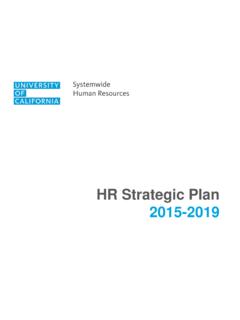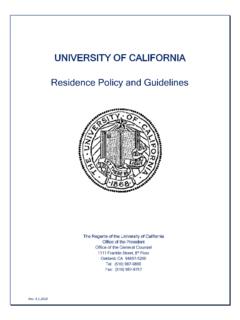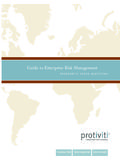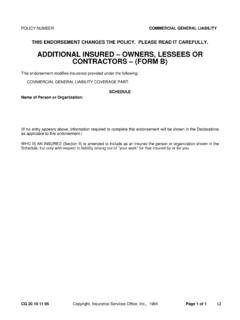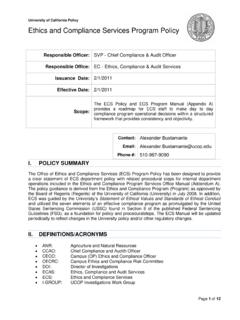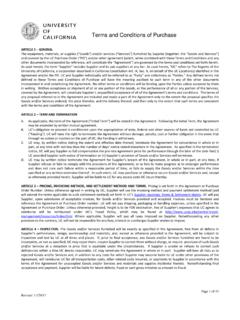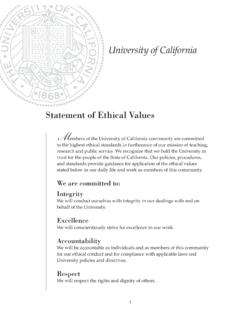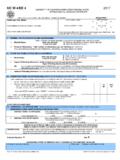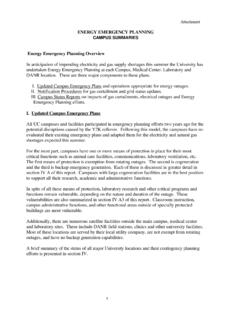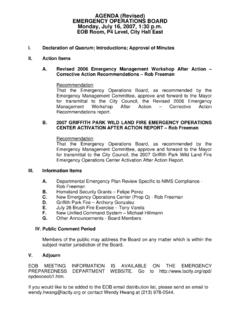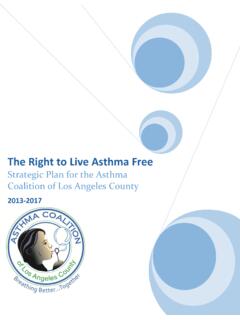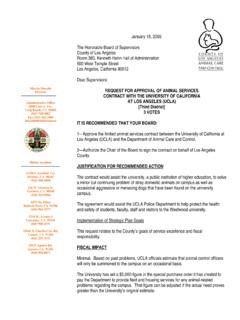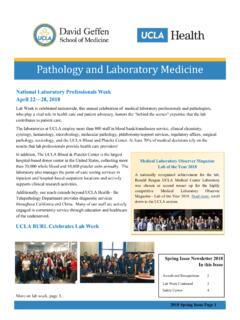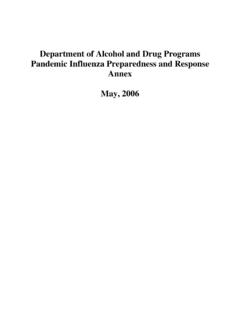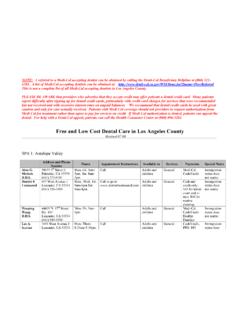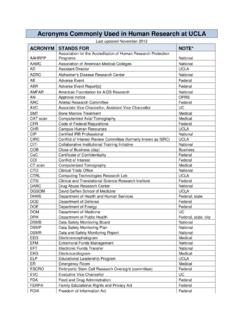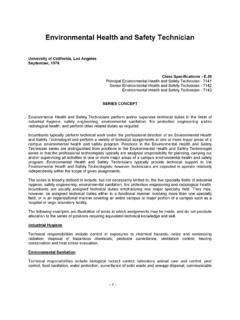Transcription of University of California Hazard Mitigation Progress Report
1 University of California Hazard Mitigation Progress Report University of California Office of the President CFO Division Office of Risk Services 2017 I. Executive Summary The Hazard Mitigation measures, programs, and projects summarized in this document reflects the University s commitment to reducing, preventing or eliminating potential risks and impacts of natural and human-caused disasters and keeping our campus communities as safe and disaster-resilient as possible. By working to reduce the University s vulnerability to the multiple hazards we face in California , our locations are able to recover more quickly and less expensively from disasters and the economic, academic, operational, and environmental impacts from these disasters will be minimized. The systemwide Hazard Vulnerability Assessment (HVA) initiative completed in 2005 continues to provide us with a road map on how to most effectively prioritize and manage a wide range of catastrophic risks.
2 By a wide margin, the greatest physical threat/risk facing the University is a catastrophic earthquake. In the HVA analysis, this was ranked as the highest threat by all UC campuses except for those located in the seismically inactive Central Valley (Davis and Merced). In recognition and response to the magnitude of the threat, the University began its systemwide structural seismic safety retrofit capital program in 1979, and is continually reviewing the seismic safety of its facilities, prioritizing buildings for remediation, and implementing seismic upgrades. Between 1979 and 2010-11, the University invested more than $4 billion in seismic safety retrofits, hospital replacement, and various seismic Hazard Mitigation projects. Since 2011, UC has devoted more than $ billion to projects that included seismic and life-safety corrections work. Major projects include UC Berkeley s Student Union and Memorial Stadium - both of which had major seismic components to their multi-faceted renovations - and projects that involve complete demolition and rebuild, such as the UC Berkeley Tolman Hall seismic replacement project.
3 UC is also undertaking large hospital seismic projects such as UCSF s Parnassus Seismic Renovation Program, which consists of a series of renovations including retrofitting the Clinical Sciences Building. Furthermore, UC has undertaken at least 39 smaller seismic projects on 9 campuses and 3 medical centers with total construction costs of $174 million (excludes soft costs such as design and engineering). Seismic Hazard Mitigation represents the vast majority of all University investment in Hazard Mitigation , commensurate with the degree of catastrophic risk. All University locations pay into the systemwide self-insurance program. The University has been successful in managing its risk by investing in proactive loss prevention and loss control programs as part of an overall Enterprise Risk Management strategy. In particular, the Be Smart About Safety (BSAS) loss prevention program has reduced losses and thereby reduced the total cost of risk.
4 Since FY2011-12, the program has funded many campus Hazard Mitigation projects and programs through BSAS and other insurance program funding sources. BSAS alone has funded 153 Mitigation projects totaling $ million that are directly related to the University s top ten-highest ranked threats. The program has also spent $ million on various campus threat and security measures, mainly security assessments and enhancements. In addition, the program has also invested $7 million in staffing campus mission continuity planner positions, in addition to approximately $440,000 on continuity planning software development. Furthermore, UC spent approximately $5 million on campus wellness programs aimed at improving the health and wellbeing of the campus community. The following table highlights the University s significant investments in non-seismic Hazard Mitigation through December 2016. Expenditures for UC Hazard Mitigation , Non-Seismic (1979-2016) Hazard Mitigation Project/Program Fund Source Amount Campus Building Fire Prevention/Life Safety Projects and Staffing BSAS $4,776,473 Campus Workplace Violence Programs/Staffing BSAS $4,340,509 Campus Threat and Security Measures OPRS $7, 293,873 Campus animal Research Facility Security/Surveillance Measures BSAS $311,511 Campus High Wind Tree Hazard Projects BSAS $68,500 Campus Public Event Crowd Control Measures BSAS $26,900 Public Health/Pandemic Control Measures BSAS $1,428,117 Wildland Fire Hazard Mitigation Measures BSAS $100,000 Mission Continuity Software Development OPRS $440,000 Campus Mission Continuity Planner Staffing OPRS $6,090,235 General emergency Response/ Hazard Mitigation Measures OPRS $887,265 Total $18,469,510 II.
5 Background In Fall 2003, the UC Office of the President formed the systemwide Safety, Security and Anti-Terrorism (SSAT) Committee to assess the state of the University with respect to overall security, exposure to threats, and ability to respond to physical hazards, including natural hazards, human-caused events, technological hazards, and terrorist acts. The mission of the SSAT was to strengthen security and safeguards at the campuses and to enhance crisis and consequence management capabilities across the University of California system. The primary goal of the SSAT was to create a consistent and comprehensive systemwide framework for physical Hazard identification, risk assessment, and Mitigation strategy development that allows for individual campus flexibility and maintains campuses prerogative to respond to campus-specific concerns and priorities. To fulfill its charge, the SSAT conducted an assessment of the University s approaches to Hazard Mitigation , preparedness, response, and recovery efforts by facilitating a comprehensive risk assessment, or Hazard Vulnerability Assessment (HVA), for each campus.
6 Specific objectives of the HVA were to conduct individual campus risk assessments and to develop a systemwide ranking for the relative risk of a threat event; to identify vulnerable campus locations or critical/irreplaceable/highly valued facilities or assets; and to identify and assess both existing and potential interim and long-term Mitigation measures. The HVA Report was issued in 2005: III. Systemwide Risk Assessment (HVA) Results A systemwide threat event ranking was subsequently developed based on the results of the individual campus HVA risk assessments (see following table). All ten campus ordinal rankings were then combined for each individual threat event to produce a systemwide relative risk ranking score (far right column) for each threat event. The compilation of campus relative risk threat event rankings produced a statistical breakpoint or cutoff that identified eleven (11) threat events that were most significant for the University .
7 In descending order of relative risk, the highest systemwide threat events or hazards were: 1. Catastrophic Earthquake 2. Laboratory Building Fire 3. Workplace Violence 4. animal or Crop Eco-terrorism 5. Residential Building Fire 6. Truck Bomb 7. Active Shooter 8. High Winds 9. Public/Sports Event Disturbance 10. Public Health emergency 11. Wildland-Urban Interface Fire THREAT EVENT/ Hazard CAMPUS RISK ASSESSMENT RANKINGS Natural Hazards Technological Human-Caused Terrorist Acts Berkeley Davis Irvine Los Angeles Merced Riverside San Diego San Francisco Santa Barbara Santa Cruz Systemwide Relative Risk Ranking Score Catastrophic Earthquake 1 17 1 1 20 1 1 1 1 1 45 Lab Building Fire 11 3 2 6 9 6 6 4 11 2 60 Workplace Violence 9 2 6 2 7 10 8 7 2 8 61 animal /Crop Eco-terrorism 2 1 10 4 1 4 13 3 15 17 70 Residential Building Fire 5 6 3 15 10 3 7 21 5 5 80 Truck Bomb 14 10 7 8 3 9 2 9 10 11 83 Active Shooter 7 5 11 10 4 5 10 17 6 13 88 High Winds 20 9 9 13 5 2 3 22 4 6 93 Sports/Public Event Disturbance 10 4 4 3 12 7 15 11 13 18 97 Public Health emergency 17 16 5 12 13 13 5 12 7 4 104 Wildland Fire 4 8 17 22 6 15 4 14 8 10 108 Mail/Package Bomb 8 15 15 11 8 11 9 8 19 16 120 Intentional Biological Agent Release 15 13 14 5 15 16 11 10 16 14 129 Power Failure 6 12
8 16 18 18 18 18 2 20 3 131 Flood 13 11 21 19 2 8 16 18 9 15 132 Civil Disturbance 3 7 18 9 11 17 24 23 14 9 135 Accidental Hazmat Release 22 14 8 14 16 14 17 13 12 7 137 Intentional Radiological Release 16 19 12 7 20 12 12 6 21 20 145 Landslide - Mudslide 12 23 23 17 20 21 14 5 3 12 150 IT Infrastructure Disruption 18 18 19 21 14 19 21 15 18 19 182 Theft of 'Select Agent' 19 20 20 16 20 20 20 19 23 24 201 Water Supply Disruption 21 22 13 20 19 23 19 24 24 21 206 Telecommunications System Failure 24 21 22 23 17 22 22 25 25 22 223 Coastal Tsunami 23 24 24 24 20 24 23 20 22 23 227 IV. Summary of Systemwide Hazard Mitigation For each of their top ten threat events, the campuses identified specific campus sites or critical/irreplaceable/high-value facilities or collections (if applicable) that would be vulnerable. Taking into consideration these vulnerable locations and assets, campuses also identified Mitigation measures that had already been implemented, as well as potential interim and long-term Mitigation measures.
9 Each campus could also choose to conduct Mitigation measure analyses for any or all of the other threats determined to be significant based on campus experience, institutional priorities, special interests, and irreplaceable at-risk assets. Campuses then submitted their campus Mitigation measure information to UCOP under attorney- client privilege for further analysis so that any significant systemwide vulnerabilities as well as best practices could be identified. V. Be Smart About Safety (BSAS) Hazard Mitigation Funding Program Since FY08-09, funding for many campus Hazard Mitigation projects and programs has occurred through the Be Smart About Safety (BSAS) loss prevention program. See the UC Hazard Mitigation Progress Report dated 2011 for relevant BSAS measures prior to 2011. The table below shows BSAS-funded campus Mitigation projects and programs for FY11-16 in each of the ten highest ranked systemwide threat events based on the results of the Hazard Vulnerability Assessment (HVA) as well as a general category applicable to multiple hazards.
10 In FY11-16 BSAS funded 153 Mitigation projects/programs directly related to these threats, returning a total of $12,203,640 to the locations to invest in Hazard Mitigation . BSAS-Funded Campus Hazard Mitigation Projects (FY11-16) Campus Project Title Hazard Mitigation Project/Program FY(s) Amount Campus Hazard Code Hazard Mitigation Project/Program Administer program to ensure the campus is adequately prepared to respond to campus and community emergencies FY11/12 $ 79,930 UCSB General ALS Paramedic Program Equipment and Supplies Supplies and equipment to upgrade UCSC Fire Dept's emergency Medical Services from Basic Life Support to Advanced Fire Support/Paramedic. FY11/12 $ 60,000 UCSC General Campus Project Title Hazard Mitigation Project/Program FY(s) Amount Campus Hazard Code BruinAlert Outdoor "Big Voice" Siren Install outdoor speaker/warning system at specific locations to increase awareness of campus emergencies FY11/12 $ 45,818 UCLA General BruinAlert Outdoor "Big Voice" Siren Install outdoor speaker/warning system at specific locations to increase awareness of campus emergencies FY11/12 $ 45,818 UCLA General Backup critical emergency management information Critical emergency management information provided to every department in electronic format FY11/12 $ 7,000 UCSF General Complete programming of on-line emergency action plans Enables UCSF to adequately prepare emergency Action Plans FY11/12 $ 50,000 UCSF General Evacuation mapping Hospital evacuation map survey, map design and installation FY11/12 $ 50,000 UCSFMC General WarnMe Implement mass notification system FY12/13 $ 25.
